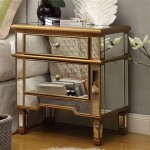Antique Dressing Mirror on Stand
Antique dressing mirrors on stands, also known as cheval mirrors or cheval glasses, represent more than just reflective surfaces. They are elegant pieces of furniture that add a touch of history and sophistication to any room. Understanding their historical context, diverse styles, construction materials, and the nuances of identifying genuine antiques is crucial for collectors and enthusiasts alike.
The history of standing dressing mirrors can be traced back to the 18th century. Prior to this period, mirrors were predominantly wall-mounted or hand-held. The development of larger sheets of glass and advancements in mirror-making techniques facilitated the creation of freestanding mirrors. The cheval mirror, with its pivoting frame allowing for angle adjustments, became a popular fixture in bedrooms and dressing rooms. These early mirrors often featured intricate carvings, gilded frames, and exquisite craftsmanship, reflecting the prevailing aesthetic sensibilities of the era.
Throughout the 19th and early 20th centuries, various styles of dressing mirrors emerged, influenced by prevailing design movements. Victorian-era mirrors often featured elaborate carvings, ornate details, and dark wood finishes like mahogany or walnut. Art Nouveau mirrors embraced flowing lines, nature-inspired motifs, and the use of materials like brass and copper. Art Deco mirrors showcased geometric shapes, sleek designs, and the integration of materials such as chrome and Bakelite. These stylistic variations allow collectors to find pieces that complement their existing décor and personal preferences.
The materials used in the construction of antique dressing mirrors contribute significantly to their value and aesthetic appeal. The frame, often crafted from wood, could be made of a variety of species, including mahogany, walnut, oak, or rosewood. The quality of the wood, its joinery, and the presence of decorative elements are key considerations. Mirrors themselves were typically made of either mercury-backed glass or later, silvered glass. Mercury-backed glass, common in older antiques, can be identified by its slightly grayish or mottled appearance. Hardware, including hinges, screws, and decorative mounts, often featured brass, copper, or other metals.
Identifying a genuine antique dressing mirror requires careful examination and attention to detail. The overall construction is a crucial indicator. Hand-crafted joinery, slight imperfections, and the use of traditional construction methods are hallmarks of antique pieces. The presence of patina, the natural aging of materials over time, is another key factor. Patina on wood, metal hardware, and the mirror itself should appear consistent and authentic. Examining the back of the mirror can reveal clues about its age and construction. Older mirrors may have remnants of original paper backing or labels.
Evaluating the condition of an antique dressing mirror is essential. While minor signs of wear and age are expected, significant damage can detract from its value. Checking for cracks or chips in the mirror, loose joints in the frame, and missing or damaged hardware is important. Restoration work, while sometimes necessary, can impact the value of the piece. A professional assessment can help determine the extent of any restoration and its potential effect on authenticity.
Caring for an antique dressing mirror requires specific considerations to preserve its integrity. Dusting regularly with a soft cloth is essential to prevent the buildup of grime. Avoid using harsh cleaning chemicals that can damage the frame or the mirror surface. Protecting the mirror from excessive humidity and direct sunlight can prevent warping and deterioration. When moving a cheval mirror, it's vital to support both the frame and the mirror to avoid stress on the hinges and prevent breakage.
The value of antique dressing mirrors on stands can vary significantly based on several factors. The age of the mirror, its style, the materials used, its overall condition, and the presence of any provenance or historical documentation all contribute to its worth. Consulting with reputable antique dealers or appraisers can provide a more accurate assessment of a particular mirror’s market value. Understanding the interplay of these factors can assist collectors in making informed decisions and appreciating the unique qualities of these historical objects.
The market for antique dressing mirrors is dynamic, influenced by current design trends and collector demand. Certain styles, such as Art Deco or Victorian, may experience periods of heightened popularity. The rarity of a specific design or the use of unusual materials can also impact its desirability. Staying informed about market trends through reputable sources can help collectors navigate the landscape and identify potential investment opportunities.
Acquiring antique dressing mirrors can be a rewarding experience. Antique shops, auction houses, and online marketplaces offer various avenues for exploration. Careful research, meticulous examination, and a discerning eye are essential when considering a purchase. Understanding the historical context, stylistic variations, and construction techniques allows collectors to appreciate the artistry and craftsmanship embodied in these beautiful and functional objects. Adding an antique dressing mirror on a stand to a room not only enhances its aesthetic appeal but also brings a piece of history into the present.

Vintage Antique Look Double Sided Vanity Mirror With Stand Gold

Antiques Atlas Antique Dressing Mirror On Stand

Full Length Cheval Mirror Floor Standing Dressing Yola Gray Antiques

All Solid Wood Dressing Mirror Pure Full Length Retro Floor European Style Bedroom China Made In Com

Antique Vanity Mirror With Stand Makeup Ornate Feminine Romantic Gold Golden Vintage Vestiesteam Tbteam Mirrors Style

Common Types And Styles Of Antique Mirrors Lovetoknow

Vintage Dressing Mirror With Drawer Shaving Stand Mens Valet Gentleman Chest Tilting Pineapple Decor

Oversized Full Length Mirror Antique Gold Handmade French Singapore

Antique Dressing Table Mirrors

Antique English Victorian Mahogany Floor Standing Cheval Mirror Circa 1860 Yola Gray Antiques Interiors








